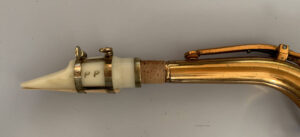Comparing Mouthpieces
I have gathered together some frequently recommended (and some not so frequently) alto saxophone mouthpieces. Most mouthpiece comparisons you hear are not always the exact same piece of music, so here I have attempted to play the same phrases on each which should help you decide on the basic sound differences. Most of these are readily available off the shelf, but I have also included an RPC custom which is the mouthpiece I have been using myself for several years and a couple of vintage mouthpieces that were hanging around in my drawer.
Scroll for more tracks
A Jody Jazz HR* 6M
B Meyer 6M
C Otto Link Tone Edge 6*
D RPC 90
E Selmer Jazz Metal F
F Selmer S80 D
G Selmer Soloist Style E
H Yamaha (plastic) 5C
I Vandoren V16 A6M
J Yanagisawa (HR) 6
K Otto Link STM 6 (metal)
L Vandoren V5 A28
M Vandoren Java A45
N Vandoren Jumbo Java A45
O Rousseau Jazz JDX7
P Hite Premiere
Q Rico Graftonite C5
R Kanee-v5
S Fobes debut
T D’Addario Select Jazz
U Thomann
On all clips I used the same reed (Rico Jazz Select 2M) and ligature, except for the metal Selmer which is a different size, however the ligature fitted well so is not going to make any significant difference to the recorded sound. There is no competition this time to guess which is which, just click on the INFO button to see the brand and model. If you want to try and guess, then don’t click on the INFO button until after listening.
Alto Mouthpiece Tip Openings and Sizes

In all the mouthpiece comparison trials I used moderate tip openings (in the region of 5 – 6*) except the RPC custom and Selmer Jazz, however I believe there is little value in looking at tip number between different models as this is only one part of the equation regarding the response, feel and/or resistance of a mouthpiece. I was comfortable with all of these except one, which I found too resistant for my taste.
Although I play on a very wide tip on tenor, I find that this does not work for me so well on alto, causing me difficulties with control so normally I prefer to stick with a tip of around .067 – .075, though my current RPC is an exception, but as I mentioned above, the actual tip is not a relevant measurement without other factors such as the facing curve taken into consideration. This explains why I found the Selmer metal jazz (at .086) to be much harder work than the RPC (.090).
Mouthpiece Comparions: Observations & Recommendations
It is a long time since I did any mouthpiece comparisons, so this has been quite an eye opener for me. I used to play on a Meyer 6M, which is somewhat a bit of an “industry standard”. I found this one to be a very good mouthpiece, though the one that jumped out as the best (and very pleasantly surprised me) was the .
Whether it sounds much different is not so relevant to me as I quite like the sound from all these, but this felt very good to play and, importantly, the response I felt as a player was inspiring. A couple of years ago I had tried a Jody Jazz metal mouthpiece and did not get a good feeling from it. I was also surprised by the Otto Link, as I have never got on with these on alto. I’m not sure this one was somehow different or whether I have become more relaxed about what suits me in the mouthpiece department. Who knows?
Are these suitable for beginners?
I am often asked for mouthpiece advice for beginners, and the piece I always recommend is the Yamaha, either a 3C or 4C. This is a very cheap but good quality mouthpiece, and is fine for learning on until you get to the point where you think you will be better with a different mouthpiece. As well as the Yamaha, the Jody, Link or Meyer are also good for beginners (though in a smaller size than I am using here), however they cost more and are not necessarily any better for you because of that.
A mouthpiece is a very personal choice, what works well for me on my sax may not work for you on yours, so the best advice I can give is to try out as many mouthpieces as possible and decide the best for you. If you cannot decide, or do not know what is wrong with your current mouthpiece or how it can be improved, then maybe this is not quite the best time to “upgrade” your mouthpiece. There is no harm in starting off with a more expensive piece, it’s just that until you get to that stage there is little real advantage in spending the extra cash.
Disclaimers
Whenever test playing different mouthpieces, the player often subconsciously adapts to create a sound close to their own “ideal” sound. I have tried to be objective and just blow each mouthpiece without trying to get the sound I usually strive for. To do this I try not to think about what I am playing, but just blow the mouthpiece. One problem with this approach is you are no longer concentrating on important issues such as intonation, which can therefore be an issue, especially with those mouthpieces that are unfamiliar. (That’s my story and I’m sticking to it)
As soon as possible, I will try to get some other alto mouthpieces for comparison, including more Vandorens, Rico, Brancher etc.
I hope you find this interesting and useful, I am happy to answer any of your questions on the forums.